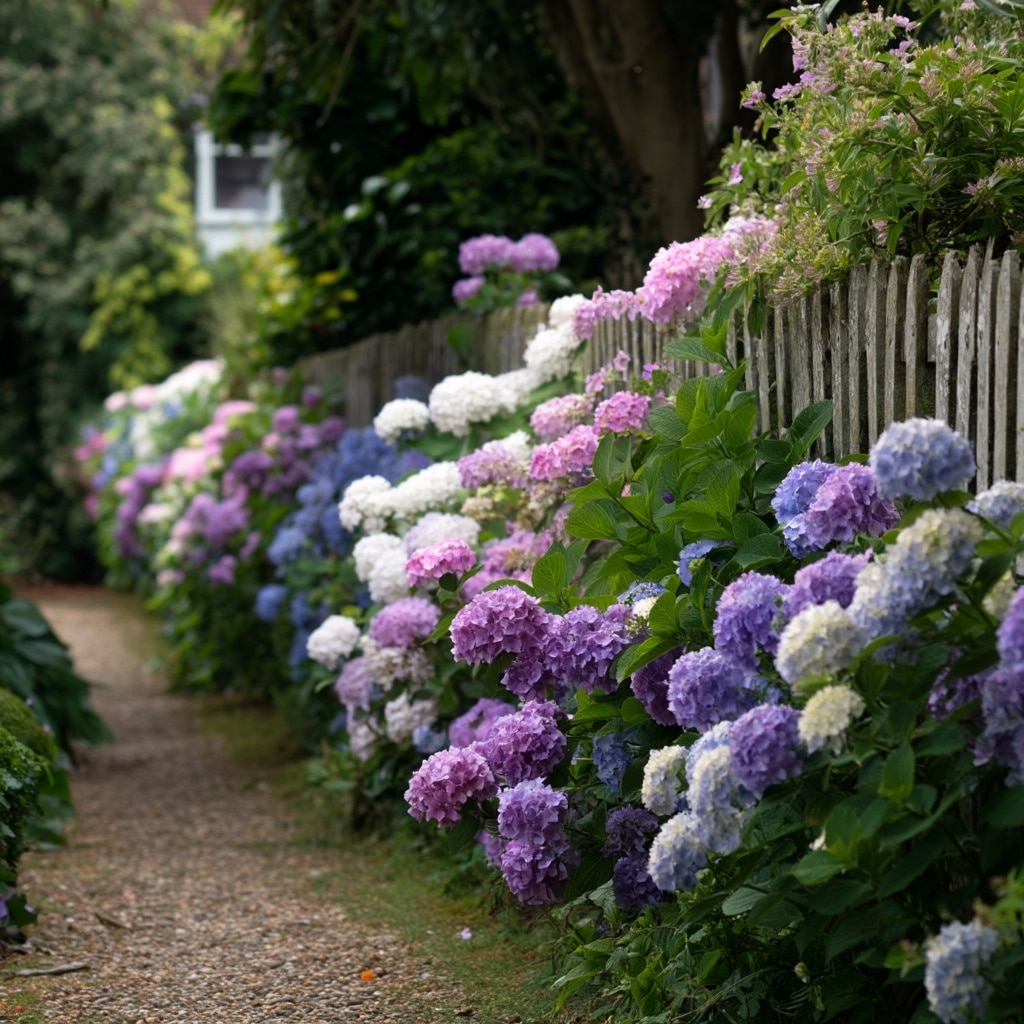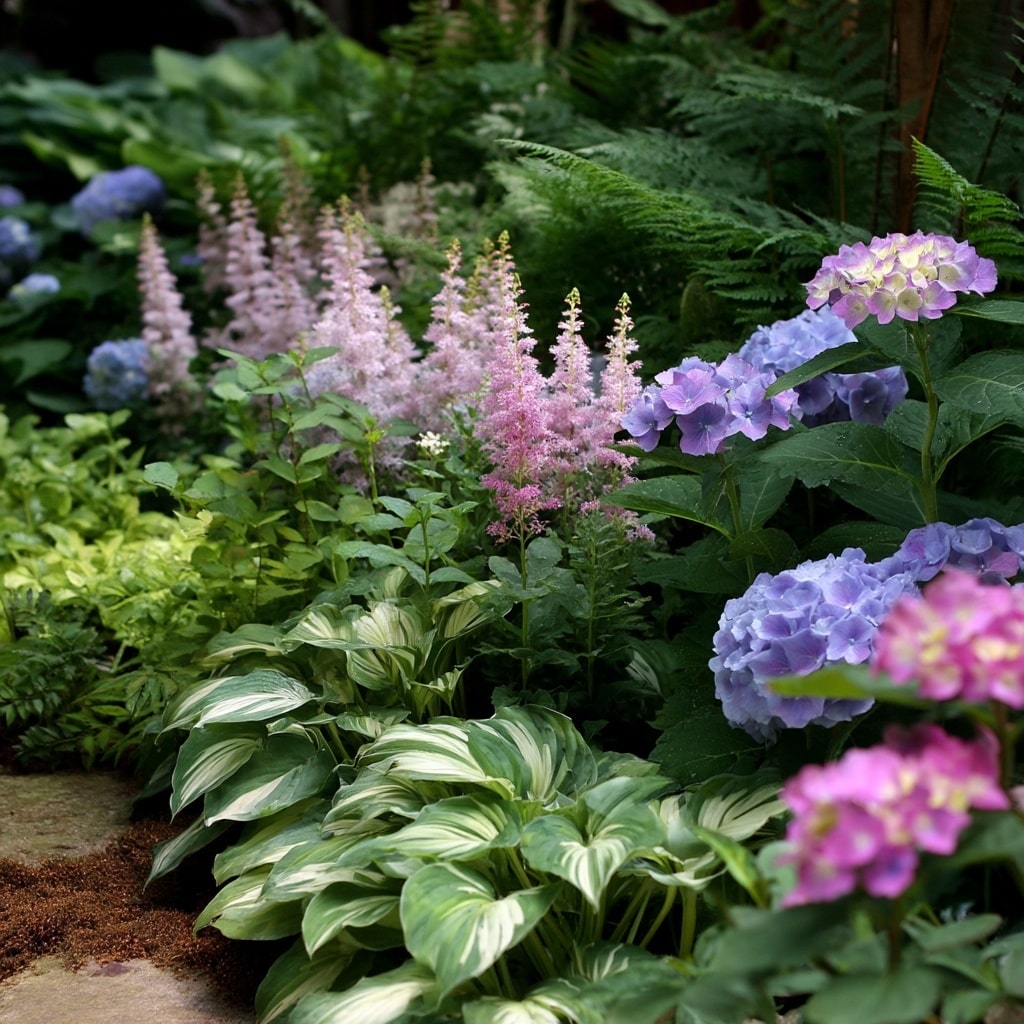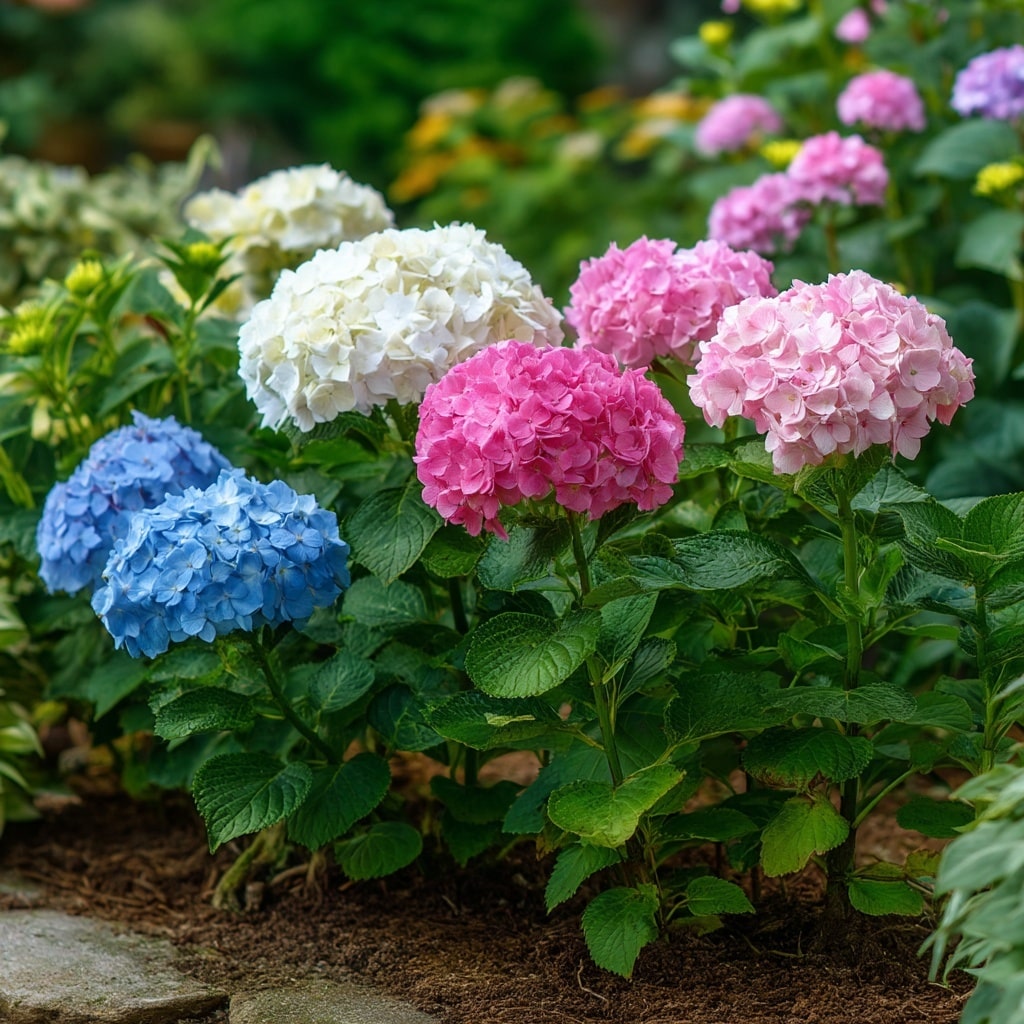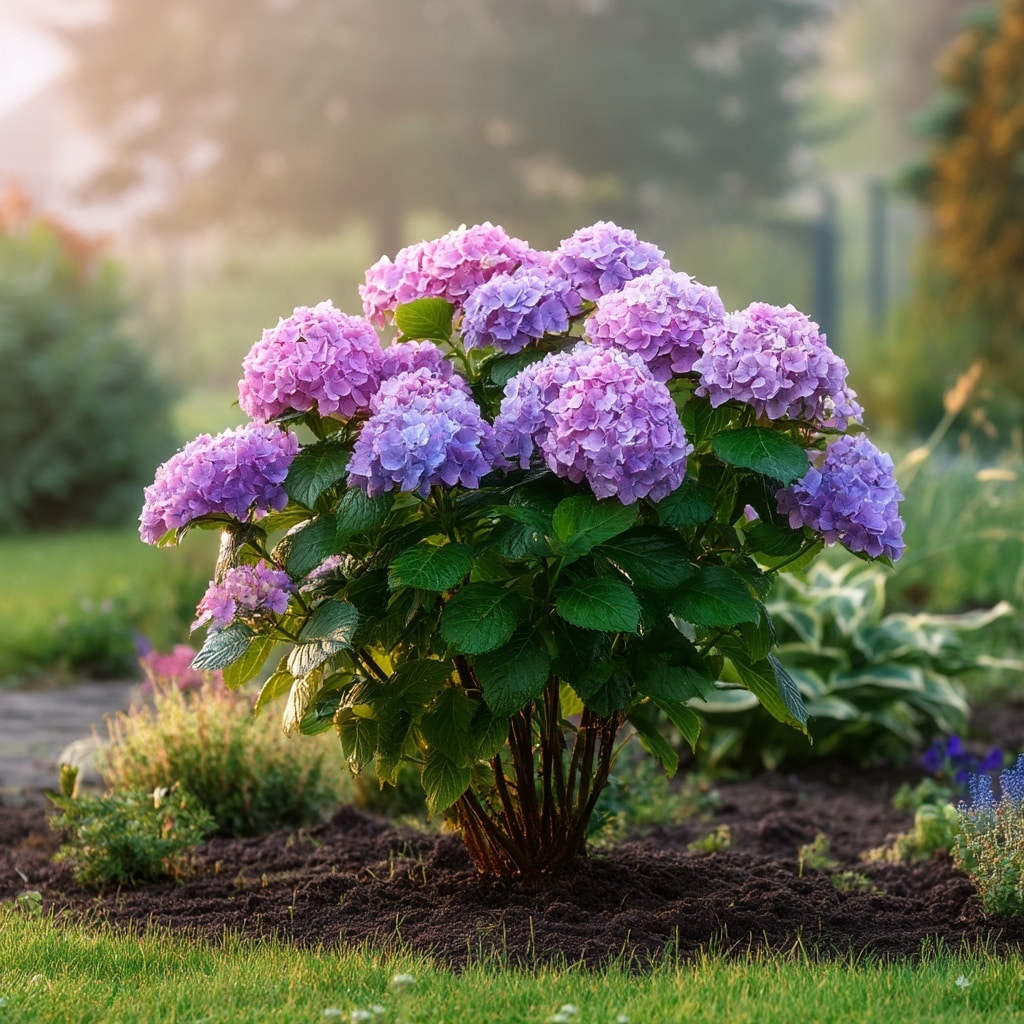Hydrangea is one of the most beloved shrubs in garden landscapes, known for its bold blooms and versatility across various settings. Whether you prefer soft pastel hues or vibrant shades of pink and blue, hydrangeas bring timeless beauty to almost any outdoor space. With so many varieties to choose from—climbing, dwarf, or tree-like types—it’s easy to find the perfect fit for your garden style. In this article, we’ll look at five beautiful and practical ways to use hydrangea in your yard this year. From elegant single plantings to lush groupings and even vertical displays, these ideas will inspire you to rethink how you use this classic garden favorite.
Table of Contents
1. Hydrangea as a Stunning Focal Point (Single Plantings)
One of the most effective ways to highlight the natural charm of a hydrangea is by planting it as a standalone feature in your garden. A single, well-chosen hydrangea can act as a living sculpture, drawing attention with its lush foliage and bold blooms throughout the growing season. This technique works especially well in flower beds, lawn islands, or even at the end of a pathway where visual impact is key.
When planning a single planting, consider larger varieties such as oakleaf hydrangea or panicle hydrangea. Oakleaf types offer seasonal interest beyond summer—starting with large cone-shaped blooms, followed by rich autumn foliage, and even dried flowers that hold their form into winter. Panicle hydrangeas, on the other hand, can be pruned into tree-like shapes, making them perfect for a more formal or architectural effect.
To make your focal plant really stand out, surround it with low-growing companions like salvia, sedum, or compact ornamental grasses. These border plants provide contrast in texture and color while allowing your hydrangea to remain the star of the show.
Quick Tip: Choose a spot with morning sun and afternoon shade for optimal flowering and healthy growth.
2. Planting Hydrangeas in Groupings for a Cohesive Look

If you’re aiming for a lush, layered garden design, planting hydrangea shrubs in groupings can create a visually balanced and serene atmosphere. Instead of relying on a single focal plant, clustered hydrangeas offer a natural flow that carries the eye across the landscape, especially when arranged in staggered patterns.
A common technique in landscape design is the “Rule of Three”—using odd numbers of plants to achieve a more organic, less rigid appearance. Three or five hydrangeas, spaced evenly or gently offset, create a soft rhythm that mimics how plants grow in nature. This layout works especially well along garden edges, beneath windows, or in large planting beds.
Try mixing different hydrangea varieties within the same color family to introduce subtle variety without overwhelming the design. For instance, pairing smooth hydrangeas with dwarf panicles offers variation in bloom shape and height while maintaining a cohesive look.
Spacing is key: leave about 3 to 4 feet between plants to allow them to grow into their full form. Over time, the grouped hydrangeas will fill in gaps, creating a seamless sea of color and texture.
Design Tip: Repetition of color and shape not only looks pleasing but also brings a calming, unified feel to your yard.
3. Using Hydrangeas as Foundation Plantings

Few plants offer the charm and curb appeal of a well-placed hydrangea near the foundation of your home. With their lush foliage and generous blooms, hydrangeas soften hard edges, frame architectural features, and add a welcoming touch to entryways or front yard beds.
Smooth hydrangeas are especially suited for this role. These compact varieties, such as ‘Annabelle’, thrive in partial shade and stay relatively low in height, making them ideal for areas under windows or close to walkways. Their round, snowball-like blooms bring seasonal interest without overpowering nearby structures.
When planning foundation beds, think beyond symmetry. Try a staggered arrangement with companion plants like boxwoods or hostas to maintain year-round texture. Adding shade-tolerant perennials such as astilbe or heuchera around the base of your hydrangeas keeps the space visually appealing even when blooms fade.
Just make sure your planting area drains well—hydrangea roots dislike consistently wet soil. Keep at least 18 to 24 inches between the plant and your home’s foundation to allow airflow and prevent moisture issues.
Pro Tip: Foundation hydrangeas benefit from mulch to retain moisture and regulate soil temperature, especially during summer heat.
4. Creating Natural Borders with Hydrangeas

Although not always the first shrub gardeners think of for hedging, hydrangea makes a striking and functional choice for borders. With their dense foliage and large blooms, they can define garden edges, line pathways, or act as living fences—all while adding texture and color through multiple seasons.
For low-growing borders, compact varieties like Hydrangea macrophylla ‘Mini Penny’ or Hydrangea serrata provide neat, manageable forms. If you’re aiming for a taller privacy screen or backdrop, go for oakleaf hydrangeas or larger panicle types, which can reach 6 feet or more in height.
Unlike formal hedges that require constant pruning, hydrangeas offer a more relaxed, natural shape. That said, regular light trimming can help maintain size and encourage fuller blooming, especially if you’re using them along a defined edge or fence line.
Spacing is essential. Leave enough room—typically 3 to 5 feet apart—so plants can mature without overcrowding, allowing air to circulate and reducing disease risk.
Landscape Idea: Use alternating hydrangea varieties along a long fence to create subtle visual rhythm and seasonal variation in both bloom time and leaf color.
5. Going Vertical with Climbing Hydrangeas

If you’re short on garden space or want to add vertical interest to a blank wall or trellis, climbing hydrangea is an elegant and unexpected solution. Though slower to establish than shrub varieties, these climbers reward patience with cascading, lacecap-style blooms and lush green foliage that turns golden in fall.
The most popular species for vertical planting is Hydrangea anomala subsp. petiolaris, a woody vine that uses aerial rootlets to cling to walls, fences, or arbors without support. Over time, it can reach impressive heights—up to 30 feet—making it perfect for dressing up outbuildings, garden walls, or even tree trunks.
Climbing hydrangeas thrive in part shade and moist, well-draining soil. In early summer, they bloom with flat-topped clusters of creamy white flowers that provide subtle beauty and attract pollinators.
Because this plant grows slowly for the first few years, it’s ideal to pair it with fast-growing perennials or annuals at the base for early-season color while it fills in.
Maintenance Tip: Once established, climbing hydrangeas require minimal care—just occasional pruning to manage direction and size.
What to Plant with Hydrangeas: Perfect Companions

Planning your garden around hydrangea shrubs is a smart strategy, especially since these bold plants tend to dominate any bed they’re placed in. To create a balanced, beautiful landscape, consider pairing hydrangeas with plants that complement their size, color, and texture.
Start by planting lower-growing perennials beneath or around your hydrangeas. These fill in gaps and create visual interest without competing for attention. Favorites include:
- Hostas – Their broad, shade-loving leaves contrast beautifully with hydrangea blooms.
- Ferns – Add fine texture and a woodland feel beneath large shrubs.
- Astilbe – Feathery plumes that add color and grace to shadier spots.
- Daylilies – Their upright, strappy leaves and colorful flowers offer a bold contrast in form.
For early-season color before your hydrangeas bloom, try azaleas or spring-blooming bulbs like daffodils and hyacinths. These provide continuity and keep the garden looking full year-round.
If you like to refresh plantings each season, add annuals such as impatiens, begonias, or coleus, which thrive in the same light and soil conditions and offer a pop of continuous color.
Design Tip: Match the water and light needs of companion plants to your specific hydrangea type to keep maintenance low and plants thriving.
Frequently Asked Questions About Planting Hydrangeas
Where Should You Avoid Planting Hydrangeas?
Avoid planting hydrangea shrubs in areas with poor drainage or consistently wet soil, as they’re highly sensitive to soggy roots. Steer clear of spots under large trees where they’ll compete for moisture and space. Also, planting too close to structures or fences can limit airflow and lead to mildew or fungal issues.
How Should You Space Hydrangeas?
Spacing depends on the mature size of the variety. In general:
- Small varieties: space 2–3 feet apart
- Medium to large shrubs: 3–5 feet apart
- Climbing hydrangeas: 6–8 feet from walls or structures
This allows for proper airflow, healthier growth, and room for your hydrangeas to reach their full potential.
Conclusion
From bold focal points to climbing displays, hydrangea offers endless landscape possibilities for every yard size and style. With thoughtful placement and the right companion plants, these versatile shrubs bring color, charm, and structure to your garden throughout the year. Whether you’re working with a shaded corner or a sunny border, there’s a hydrangea solution that fits beautifully into your outdoor space.





